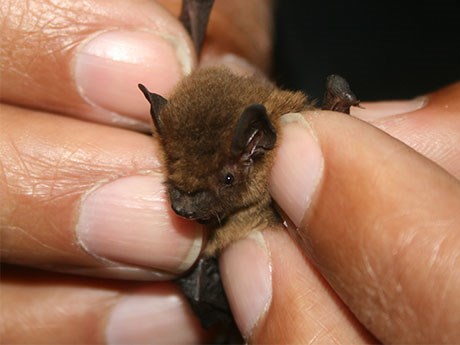Designation as endangered species requires mining companies to preserve bat habitats
Over and above all of the other studies required of them, mining companies planning new and expanded operations or executing a closure plan are now expected to incur the additional expense of ensuring they aren’t destroying or damaging bat habitats.
“Before 2013, none of the bats in Ontario were protected by any rare species legislation,” said Derek Morningstar, a terrestrial ecologist with Golder Associates. “Now, they’re listed on both the provincial Endangered Species Act and the federal government’s Species at Risk Act.”
Bat populations in Ontario have declined by up to 95 per cent due to a condition called white nose syndrome, which is caused by a fungus that eats away at their skin while they’re hibernating in caves and underground spaces.
Biologists estimate that between five and six million bats have been killed since the discovery of the fungus in 2006, “but we don’t really have an accurate count,” said Morningstar.
Bat habitats protected by endangered species legislation include hibernation areas and maternity roosts.
Operating mines don’t tend to attract bats, but there are a lot of abandoned mines in Northern Ontario, said Morningstar.
“Sometimes, they’re backfilled a bit, or covered by a pile of rocks, but a bat only needs a half-inch space to get in.”
Capping a hole in the ground could potentially deprive the bats of an underground habitat, so the first thing mining companies need to find out is if there are any bats using it.
“That in itself can be a big challenge,” said Morningstar. “If it’s a nice big space, you could walk in and see the bats hanging from the roof, but in Ontario there are laws that prevent the entry into abandoned mines for safety reasons, so you can’t do an internal survey.”
The only alternative is an external survey conducted during August or September when bats swarm prior to going into hibernation. However, detecting and counting bats is challenging because they fly at night when you can’t see them, call at inaudible ultrasound frequencies so you can’t hear them and hide during the day when you can’t find them.
Golder biologists use technologies such as acoustic detectors, radar, and thermal imaging cameras to perform bat surveys.
If bats are detected in the vicinity of an abandoned mine, accommodations have to be made to preserve the habitat. The most common technique is the installation of a bat gate – a steel grate that keeps people out but allows bats to continue to use the underground space.
Unfortunately, the Ministry of Northern Development and Mines doesn’t consider bat gates as a permanent closure solution, so mining companies have to continue to
monitor them.
Surface construction activities such as tailings pond expansions also require bat surveys to ensure the preservation of maternity roosts in trees or buildings, said Morningstar.
Bats copulate in August and September while swarming, but the females store the sperm through the winter, get pregnant in the spring and roost in trees and buildings during the summer. If surveys find that bats are roosting in trees in an area of a proposed mining activity, the mining company either has to preserve the trees or accommodate the bats by erecting bat boxes or bat condos on poles.
Bats are worth protecting because “there aren’t very many nocturnal insectivores,” said Morningstar. “Birds don’t do it and frogs can’t fly. Bats, however, eat their body weight of insects every night.”
The endangered species legislation places the onus of responsibility on mining companies to ensure they aren’t negatively impacting bat habitats regardless of any other permits they receive for mine development or closure plans.


